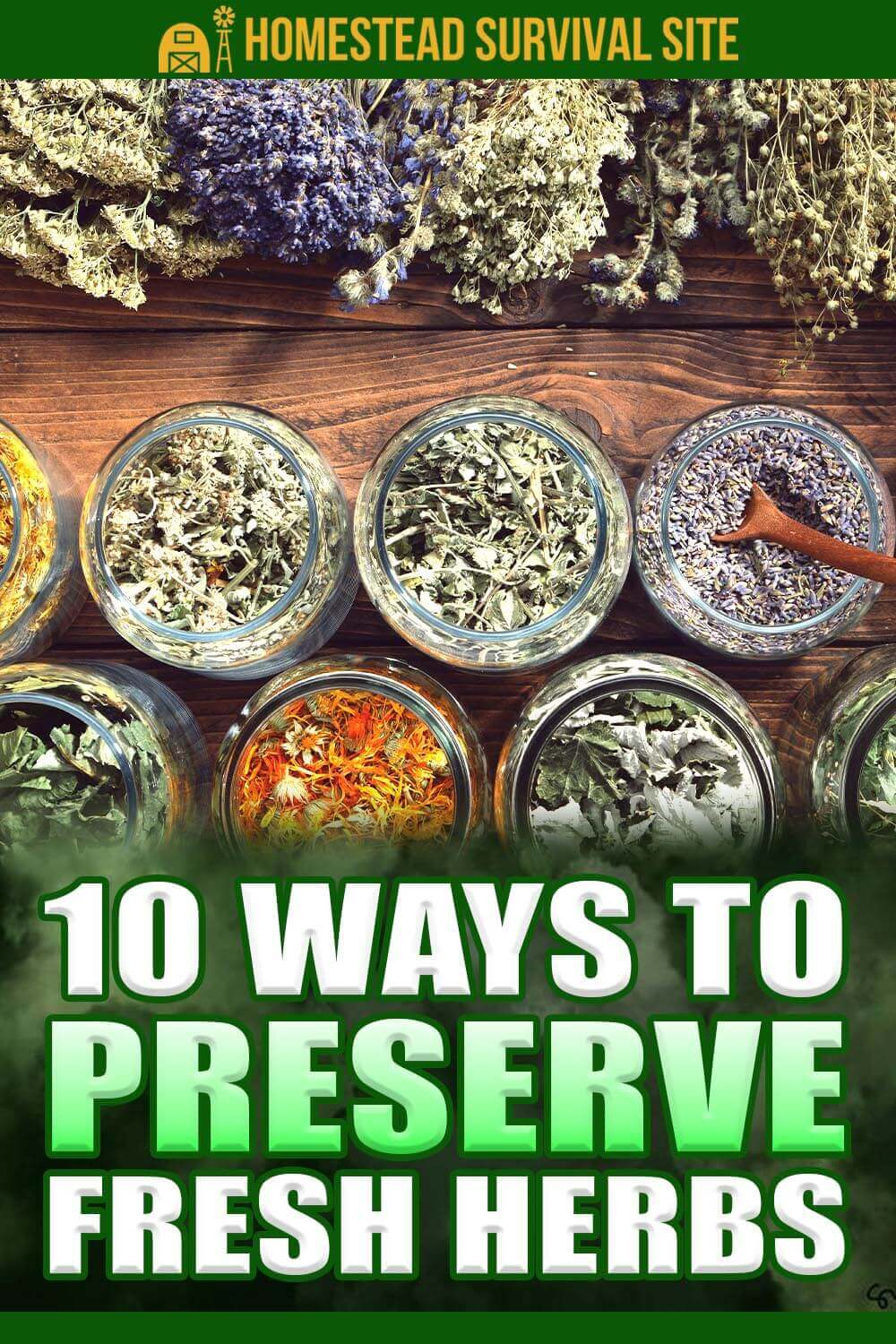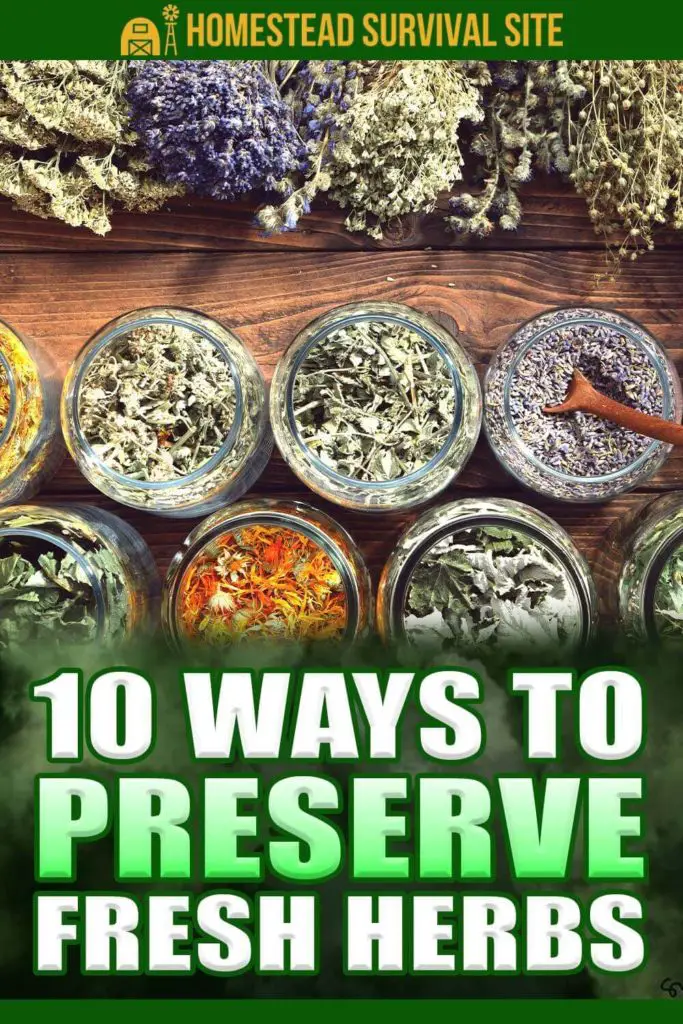Estimated reading time: 8 minutes
Waste not, want not. According to the Dictionary of American Proverbs, this well-known saying can be traced back to 1772. It is a mantra for many homesteaders.
Herbs are delicious straight from the garden, but their freshness can fade quickly. You should discard herbs when their leaves turn dark or brittle, or if their stems show any traces of mold.
If you have a bountiful supply of home-grown herbs this year, you may be looking for new ways to preserve them. Here are ten ways to preserve fresh herbs so you can follow the sage wisdom of that old proverb.
Want to save this post for later? Click Here to Pin It On Pinterest!
The first step is to harvest herbs at peak freshness and flavor. The right time to do this varies according to the type of plant. Here is a general guide:
- Foliage plants — Harvest when the plant is beginning to form buds.
- Flowering plants — Pick when the blooms are newly opened.
- All plants — Pick in the morning on a sunny day when plants have dried, but the air is still relatively cool.
The next step is to wash your herbs to remove any debris or organisms that can cause decay. You can spin dry your herbs in a salad spinner and then spread them out on a towel to remove any excess water.
In either case, do not wash herbs until you're ready to use or preserve them as the added moisture will cause them to wilt more quickly. Now, trim the ends of the plant stems and remove any brown or wilted leaves.
1. Freezing
Freezing your herbs is the easiest method, and the plants will retain much of their flavor. Parsley, cilantro, chives, tarragon, thyme, sage, bay, rosemary, and basil all freeze well.
You can freeze pieces or entire leaves by arranging them in a single layer on cookie sheets and then placing the cookie sheets in a freezer. You then can store the frozen pieces in an airtight a freezer bag or other freezer-safe container. To use, simply remove what you need one piece at a time.
Another method is to chop the herbs and then place them in the sections of an ice cube tray and add a little water to each section. One tablespoon of chopped herbs per cube works well for recipes.
Or you can blend the herbs with a little oil or water into a paste before freezing it in an ice cube tray.
2. Drying
Drying herbs is another popular preservation method. Dried herbs are perfect for teas, herbal oil infusions, cooking recipes, tinctures, and syrups.
Air Drying – Secure gently washed and trimmed stems together using twine or a rubber band and hang them upside down in a warm, dry, well-ventilated space that is away from direct sunlight.
Leave them to dry until the leaves crumble, which can take anywhere from one to four weeks. Then store the dried herbs in an airtight container for up to a year. (Tip: Tie a piece of paper with the name of the herb to the string to avoid confusion later.)
Oven Drying – If you live in a humid climate or if you just want to speed up the process, you can use your oven to dry herbs. Spread them on a parchment paper lined baking sheet and place in a preheated 150° F oven with the door slightly ajar.
Check the herbs frequently and remove them when they are crumbly. The process will take one to four hours. Store dried herbs in an airtight container for up to a year.
Microwave Drying – An even speedier herb drying alternative is to use a microwave. Spread individual plant leaves out onto paper towels, then cover them with another layer of paper towels. Place the layer into the microwave and heat it on high at 20-second intervals for one to three minutes. Rearrange leaves as needed to ensure they dry evenly.
Herbs are dry when they are crunchy to the touch. Allow the leaves to cool completely before storing them in an airtight container. You also can use your food dehydrator to dry your herbs. Check your manual for the correct time and temperature.
Tray Drying – You can place flower blooms out on trays, dehydrator racks, or clean window screens to air dry. Place them out of direct sunlight where they will obtain good air flow. (Tip: Lavender buds tend to fall when drying whether they are on trays or hanging. Try tying your lavender in bunches inside a cloth or paper bag to catch any fallen buds.)
3. Fermenting
Did you know you can ferment your herbs? It’s an excellent way to lock in flavor while adding probiotics and other health. You can ferment herbs in their whole leaf and stem form or by grinding them into a paste.
You can find some great recipes in the book, Traditionally Fermented Foods by Shannon Stonger.
4. Saving Seeds
Another way you can lengthen the use of your garden herbs is by saving seeds. You can fill up small jars with coriander (cilantro seeds), celery, fennel, and dill seeds for cooking purposes or to start new crops next year.
5. Preserving in Honey
Do you use honey for cooking and baking? Then you may want to preserve your herbs by storing them in honey. Here is a video on how to make oregano-infused honey. And here is a recipe for herbal-infused honey.
6. Preserving in Sugar
Preserving herbs in sugar is a great way to add zest and flavor to your baked goods, teas, coffee, lemonade or cocktails. Here’s how.
First, crush a handful of sprigs of the fresh herbs with a wooden spoon to release their oils. Next, mix two cups of granulated white sugar with the herbs in a clean jar. Seal and store the jar in a cool, dark place.
Stir the mixture once a day to break up any clumping that may occur in the first few days. As herbs dry, the clumping will cease. Stir the dried leaves so they intersperse throughout the sugar. Then seal the jar for another 10 to 14 days to allow the flavor to fully infuse.
Here is a recipe for lavender infused sugar.
7. Infusing Oils
You can also preserve your herbs by using them in soothing oils. Be sure to use fresh oil — olive oil and sunflower oil work well — so the infusion will last longer.
You’ll need the following supplies:
- Dried, coarsely chopped herbs.
- A clean and dry glass jar with a lid.
- A strainer and cheesecloth (or fine-weave towel).
- Another jar or bottle for storage. (Amber glass that blocks light is preferable.)
How to make herb-infused oil:
Directions:
- Fill the jar to the top with herbs. Pour oil slowly over the herbs. Using a knife, move the herbs around in the jar to make sure all air pockets are filled. Be sure to add enough oil to cover the herbs and to fill the jar.
- Next, cover the jar and give it a few shakes. Place the jar on a plate or a towel in a cool location away from direct sunlight. Every day or so, give the jar a shake.
- After four to six weeks, strain the oil into another clean jar or a bottle through the cloth-lined strainer. Squeeze the cloth to get out all the oil. Now cork and label your jar or bottle. If stored at room temperature, the oil will stay fresh for up to a year.
Here’s a video that shows how to make two herbal-infused oils.
8. Infusing Vinegars
Another way to use your bountiful herb harvest is by making herb-infused vinegars or oxymels, which are herbs that are infused in honey or vinegar. Oxymels can be used to help soothe sore throats, or you can use them as salad dressings or beverages.
Here is a recipe for oregano-rosemary-marjoram vinegar.
9. Mixing with Butter
Another tasty way to use your herbs is by making an herb butter. It’s easy and delicious. All you need to do is chop up your favorite leafy herb and mix it in butter that has softened at room temperature. (Tip: Tarragon works well.)
Wrap the herb butter in greaseproof paper, twisting to close the ends. You can keep herb butter in the refrigerator for two weeks or you can freeze it for up to six months.
Making Pesto
Although basil is the herb most commonly associated with pesto, you can make pesto with many other plants, including mint, chives, and parsley. You can preserve a large herb harvest by making pesto and freezing it in ice cube trays. (Do not add water).
Here are a few pesto recipes to try. This article has recipes using parsley, cilantro, sage and tarragon.
Please take careful note that herbs in oils and butters can spoil easily. To avoid any risk of disease, be sure to refrigerate them and use them within two weeks, or you may freeze them for more extended storage.
Now that you know all the ways you can preserve your fall herb harvest, you may want to consider growing them year-round. Herbs adapt well to indoor growing.
Like this post? Don't Forget to Pin It On Pinterest!













